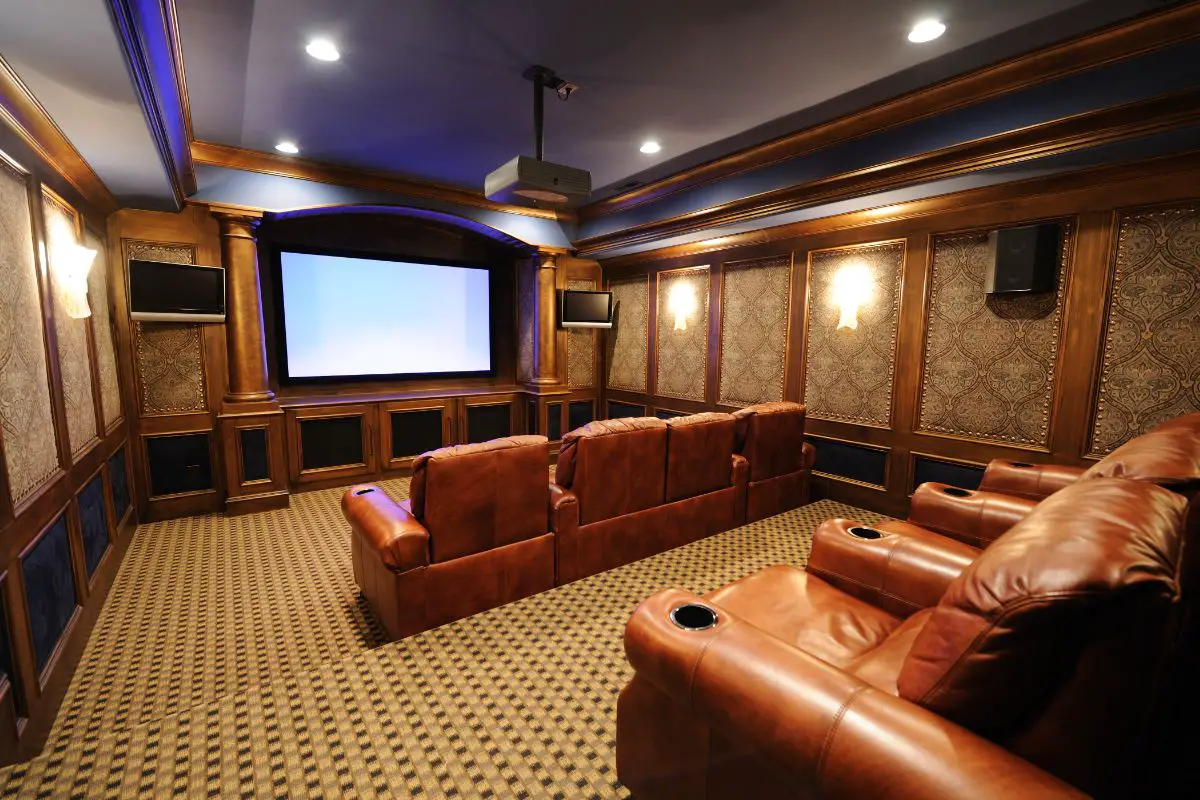My local movie theater has 16 screens and I’ve noticed that when I look up the showtimes on Fandango, they have a pretty cool feature where you can see which seats are available even before going to the checkout or even selecting your showtime. When you click on the seat availability screen, you obviously see how many chairs are in the theater, but it also does a really good job of letting you know how big the screen is compared to the rest of the space.
You might not be seeing the movie in their one or two IMAX screens, but you might get lucky and see it in one of their bigger theaters that has a screen comparable to the IMAX theater. By the way, check out this page to see where all the IMAX screens are located in the US.
Seeing that my 16-screen theater has a handful of different-sized screens made me wonder, how big is the average movie theater screen?
For most movie theaters, the screen size is influenced by the aspect ratio, which is the ratio between the screen’s width and height. Traditional cinemas typically utilize widescreen formats with 1.85:1 to 2.35:1 aspect ratios, resulting in screen heights of about 16 to 21 feet and varying widths. If you’re curious about a specific movie theater’s screen size, knowing its aspect ratio can help you estimate its dimensions.
Average Movie Theater Screen Size
When it comes to enjoying a movie, the size of the screen matters. In this section, we’ll dive into the average movie theater screen size, along with variations based on factors such as width and height, aspect ratios, and IMAX theater screens.
Width and Height
A critical factor in determining the movie-watching experience is the screen’s width and height. The average movie theater screen ranges from 70 feet to 40 feet wide, depending on the theater’s size, aspect ratio, and viewing distance. Smaller theaters may have a screen size of around 30 feet, while some theaters boast screens up to 100 feet wide.
Aspect Ratios
The aspect ratio, which refers to the ratio between the width and the height of a movie screen, also plays an important role in determining the screen’s size. In general, the average movie theater screen size is between 16×9 feet or 20×12 feet, with some movie screens even larger at 28 feet wide by 16 feet high. Aspect ratios can vary depending on the film format, but these are the most typical sizes found in movie theaters.
IMAX Theater Screens
For an even more immersive movie experience, IMAX theaters offer significantly larger screen sizes. IMAX screens can reach an impressive width of over 100 feet. The combination of a large screen size, high-quality visual and audio technologies, and unique aspect ratios such as 1.43:1 or 1.90:1 provides moviegoers with an unparalleled cinematic experience.
In summary, the average movie theater screen size depends on various factors, including width, height, aspect ratios, and whether it’s an IMAX theater. With this knowledge, you can choose the optimal movie-watching experience tailored to your preferences.
Screen Technologies
Projection Systems
When it comes to movie theater screens, a crucial component is the projection system used to display the images and video onto the screen. Projection systems have evolved over time, from the traditional film projectors to the advanced digital projectors used today.
In the past, film projectors were the standard for movie theaters. They relied on celluloid film reels which were mechanically fed through the projector, with light passing through the transparent film to project the images onto the screen. While film projectors provided a certain level of charm and nostalgia, they were prone to degradation and damage over time, which could affect the quality of the displayed imagery.
Digital Projectors
Nowadays, the majority of theaters have transitioned to using digital projectors, which offer numerous advantages over their film-based counterparts. Digital projectors allow for a higher resolution, superior color reproduction, and better image quality. They can also easily accommodate a variety of aspect ratios for different types of content.
With digital projectors, you no longer need to worry about the physical degradation of film reels. Digital files can be reliably stored and transmitted, which reduces the risk of quality loss over time. Another significant advantage is that they can be quickly and easily updated with new technology, keeping movie theaters on the cutting edge of visual presentation.
One notable digital projection technology is IMAX, which boasts screens over 80 feet wide and delivers an incredibly immersive viewing experience. IMAX enhances the clarity and brightness of the projected images, making it a popular choice for blockbuster films and nature documentaries alike.
In summary, the technology behind movie theater screens has come a long way over the years. The shift from film projectors to digital projectors has resulted in improved image quality, versatility, and reliability that benefits both theater owners and moviegoers alike. As technological advancements continue, you can expect the movie-going experience to only get better.
Sound in Movie Theaters
Sound Systems
In a movie theater, the sound system plays a crucial role in enhancing your overall viewing experience. Most movie theaters have speakers placed behind the screen, with tiny perforations in the screen to allow sound to pass through. Typically, there are three speakers located behind the screen – at the far left, center, and far right.
Modern theaters often use advanced surround sound systems that deliver immersive and realistic audio experiences. This helps draw you into the movie and creates a heightened level of engagement.
Sound Quality
Sound quality is one of the most significant factors contributing to your movie-watching experience. It’s essential for the audio to be clear, crisp, and well-balanced, making sure you don’t miss any critical dialogue or sound effects.
Theater auditoriums are designed not only to provide you with stunning visuals, but to also support a high-quality sound experience. Through features like innovative seating and moving audio, PFL (Premium Large Formats) theaters aim to create a powerful sensory experience with improved sound quality, which in turn provides you with more enjoyment as you watch your favorite films.
The Viewing Experience
Seating
When you visit a movie theater, one of the key factors determining your viewing experience is the seating arrangement. Theaters come in various sizes, from small independent ones to large multiplexes with multiple auditoriums, offering different seating capacities. Choosing the right seat can make a significant difference to your overall movie-watching experience.
Viewing Distance
A crucial aspect of the viewing experience is the distance between your seat and the screen. The optimal viewing distance depends on the size of the movie theater screen, which typically ranges from 30 to 100 feet wide. In general, a larger seating capacity is associated with a larger screen, and therefore, a greater viewing distance is recommended.
To ensure every audience member experiences the best picture quality, movie theaters are designed in such a way that each seat provides a good viewing angle. However, personal preference also plays a role in the optimal viewing distance. Some people prefer sitting closer to the screen, immersed in the movie, while others enjoy sitting farther away to observe the entire screen comfortably.
Visibility
Finally, the visibility of the movie screen is crucial for an enjoyable theater experience. This includes both the screen’s brightness and resolution. Movie theaters usually project images at a 2.40:1 aspect ratio which ensures a consistent and high-quality image for most productions. Additionally, modern theaters use digital projectors with high-definition resolutions, further enhancing the picture quality.
Keep in mind that where you sit in the auditorium can also impact visibility, particularly in a packed screening. If you’re seated too far off to the side, the image might be distorted by the screen’s edges. On the other hand, sitting too close could result in a cramped view. Therefore, it’s essential to choose a seat that provides you with an ideal balance of distance and angle to enjoy the movie to the fullest.
Overall, the seating, viewing distance, and visibility of movie theater screens all play a significant role in shaping your cinema-going experience. Optimal arrangements will vary depending on the size of the movie theater and your personal preferences, but finding the right balance will ultimately enhance your enjoyment of the film.
Modern Movie Theater Trends
Multiplexes and Amenities
In recent years, multiplexes have become the standard for movie theaters. These modern movie theaters often contain multiple auditoriums, allowing for a variety of films to be shown at once. As a movie-goer, you can now enjoy numerous amenities that cater to your comfort and convenience. These may include reclining seats, reserved seating, and even in-theater dining options. Furthermore, many multiplexes offer expanded concession options and a bar, giving you a more comprehensive and enjoyable cinematic experience.
Hollywood Blockbusters and IMAX Films
Hollywood blockbusters have increasingly pushed the boundaries of visual and audio effects, leading to the rise in popularity of IMAX theaters. As a film enthusiast, you may already know that IMAX films are specifically designed for larger screens and high-resolution projections. The average movie theater screen size typically ranges from 70 feet to 40 feet wide, depending on factors like the movie theater size, aspect ratio, and viewing distance. However, IMAX screens are significantly larger, often measuring over 100 feet wide, which greatly enhances your viewing experience.
In addition to the larger screen size, IMAX films usually feature state-of-the-art sound systems. These powerful systems provide you with a fully immersive experience that allows you to appreciate the dynamic soundscapes and intricate details of your favorite Hollywood blockbusters.
When visiting modern movie theaters, you can expect to experience an enhanced and unforgettable viewing experience, thanks to the combination of innovative theater design, industry-leading technology, and increasingly captivating films. So whether you prefer an intimate auditorium to watch a thought-provoking indie film or an IMAX theater to lose yourself in the latest Hollywood blockbuster, today’s movie theaters indeed cater to a wide range of preferences.
- Best Movie Theater Rewards Programs in 2023 - July 23, 2023
- What is the Average Movie Theater Screen Size? - June 25, 2023
- 8 Movies Like The Social Network - June 25, 2023








